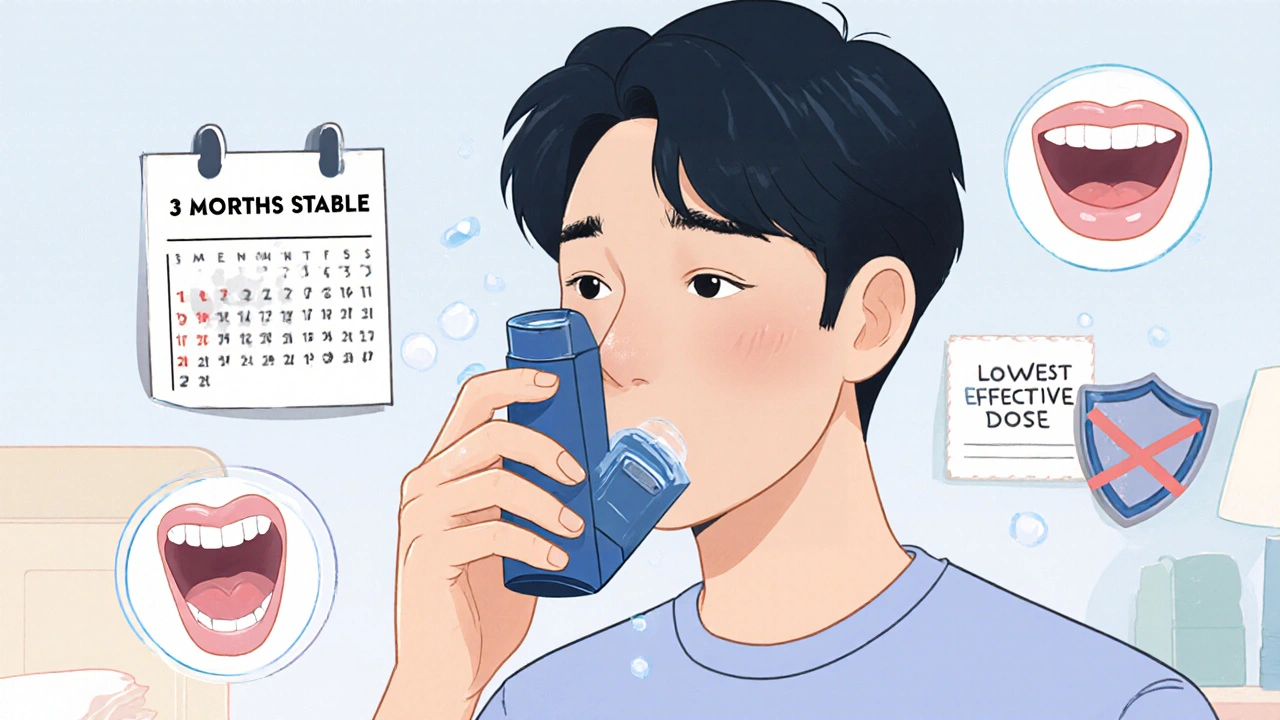
For millions of people with asthma, inhaled corticosteroids (ICS) are the backbone of daily control. They stop inflammation before it starts, prevent flare-ups, and keep you breathing easier. But if you’ve been using them for months or years, you might have noticed a hoarse voice, a fungal infection in your mouth, or unexplained bruising. These aren’t rare - they’re common. And they’re not always unavoidable. The truth is, most side effects from asthma steroids can be minimized - even reversed - with simple, proven steps. You don’t have to accept them as part of the deal.
What Are Inhaled Steroids Really Doing?
Inhaled corticosteroids like fluticasone, budesonide, and mometasone work directly in your lungs. Unlike oral steroids that flood your whole body, these are designed to target only the airways. They reduce swelling, mucus, and sensitivity so your lungs don’t overreact to triggers like pollen, cold air, or exercise. But no drug is perfect. Even though most of the medicine stays in your lungs, some gets swallowed or sticks to your throat and mouth. That’s where side effects come from.
Not all inhaled steroids are the same. Fluticasone has higher systemic absorption - meaning more of it enters your bloodstream - compared to budesonide or ciclesonide. A 2015 study in the Journal of Allergy and Clinical Immunology found fluticasone’s absorption rate is 30-40%, while ciclesonide’s is just 2-3%. That’s a huge difference. If you’re on a high dose and experiencing side effects, switching to a lower-absorption steroid might be the solution - not stopping treatment.
The Most Common Side Effects (And How to Stop Them)
Most side effects are local - meaning they happen right where the medicine lands. The top three are:
- Oral thrush (a white, patchy yeast infection in the mouth): Affects up to 7% of users on higher doses. Real-world data from the UK shows fluticasone users have nearly twice the risk compared to budesonide users.
- Hoarseness or voice changes: Happens when medicine irritates the vocal cords. Up to 38% of long-term users report this.
- Throat irritation or coughing: Often caused by poor inhaler technique or dry powder inhalers that don’t release smoothly.
Here’s the good news: you can cut these risks in half - or more - with two simple habits.
1. Use a spacer. If you’re using a metered-dose inhaler (the kind that sprays), a spacer is non-negotiable. Without one, only 10-20% of the medicine reaches your lungs. The rest sticks to your mouth and throat. With a spacer, that jumps to 60-80%. A 2020 review showed spacers reduce throat deposits by 70-80%. They’re cheap, reusable, and easy to use - even for kids.
2. Rinse and spit. After every puff, swish water in your mouth for 10 seconds and spit it out. Don’t swallow. This simple step cuts thrush risk by 50-60%, according to a Cochrane review of 17 studies. It also cuts hoarseness by more than half. Many people forget this step because they’re in a rush. But skipping it is like spraying paint on your walls and then wiping it off your hands - you’re wasting the medicine and inviting side effects.
Systemic Side Effects: What You Need to Watch For
When the medicine gets into your bloodstream, it can affect your whole body. This is rare at low doses, but becomes more likely at higher doses - especially over time.
Adrenal suppression: Your body makes its own cortisol, a natural steroid. Long-term, high-dose ICS can tell your body to stop making it. Symptoms? Fatigue, dizziness, nausea, low blood pressure. This isn’t something you can test yourself for. If you’ve been on more than 500 mcg of fluticasone daily for over six months and feel constantly tired, ask your doctor about a salivary cortisol test. Newer guidelines now recommend this for patients on high doses.
Bone thinning and fractures: People over 65 on high-dose ICS (above 500 mcg/day) have a 31% higher risk of fractures, according to a 2023 study in Age and Ageing. If you’re in this group and have been on ICS for more than five years, ask about a bone density scan.
Skin thinning and bruising: High-dose users - especially older adults - often notice easy bruising or skin that tears easily. A New Zealand study found 34% of people on high-dose ICS for over five years had significant skin thinning. If you’re seeing unexplained bruises, especially on your arms or legs, it’s worth mentioning.
Pneumonia risk: For people over 65, high-dose ICS increases pneumonia risk by 70%. That’s not a huge number in absolute terms - rising from 5.2 to 8.9 cases per 100 people per year - but it’s real. If you’re older and on high-dose ICS, get your flu and pneumonia shots every year.

Dose Matters More Than You Think
Many people stay on the same dose for years, even if their asthma is well-controlled. That’s a mistake. The goal isn’t to take the most - it’s to take the least that still keeps you safe.
Research shows that 65-75% of systemic side effects are tied to unnecessary high doses. A 2022 GINA report found that patients who worked with their doctors to step down their dose - while keeping asthma under control - cut their risk of side effects dramatically.
Here’s how to approach it:
- Make sure your asthma is stable for at least 3 months - no rescue inhaler use, no flare-ups, no nighttime symptoms.
- Ask your doctor if you can reduce your dose by 25-50%.
- Monitor closely for 4-6 weeks. Keep a symptom diary.
- If you stay controlled, you can likely stay on the lower dose.
Don’t try this alone. Dose reduction needs supervision. But if your asthma is quiet, you might be able to cut your dose in half - and cut your side effect risk with it.
Special Groups: Kids, Seniors, and Pregnant People
Children on ICS: A 2022 study of over 4,000 kids showed that standard doses cause only a tiny, temporary dip in growth - about 0.7 cm per year. That’s less than the natural variation in growth. No long-term effect on final height. But high doses (over 800 mcg/day) raise cataract risk by 2.3 times. So stick to the lowest effective dose.
Older adults: As mentioned, bone and lung risks go up. But so does the benefit - older people with asthma are more likely to end up in the hospital. Don’t avoid ICS because of fear. Instead, work with your doctor to use the lowest dose possible, add a spacer, and get regular check-ups.
Pregnant people: Budesonide is the safest choice. It’s been studied in over 15 years of pregnancy registries with no increased risk of birth defects. Fluticasone is less studied - so if you’re pregnant or planning to be, ask your doctor if switching to budesonide makes sense.

New Tools and Future Options
Technology is helping. Smart inhalers now track when you use your device and whether you’re using it right. One FDA-cleared device in 2023 catches technique errors with 92% accuracy. If your doctor doesn’t mention these, ask. They’re becoming more common.
There’s also emerging research on blood tests that can tell you how much steroid you really need. The SARP-3 study showed that if your blood eosinophils are above 300 cells/μL, you can often cut your ICS dose by half and still stay controlled. It’s not available everywhere yet - but it’s coming.
And new drugs are on the horizon. AZD7594, a next-gen inhaled steroid from AstraZeneca, showed 90% less adrenal suppression than fluticasone in early trials. Biologics like dupilumab are already helping people with severe asthma cut their steroid use by 70%. If you’re on high-dose ICS and still struggling, ask your specialist if you’re a candidate for one of these newer treatments.
What Most Doctors Don’t Tell You
A 2023 report found that only 29% of primary care visits included a check on inhaler technique. And only 39% of doctors routinely ask about side effects. That means most people are left to figure it out on their own.
Here’s what you need to ask at your next appointment:
- “Am I on the lowest effective dose?”
- “Can we check my inhaler technique?”
- “Should I be using a spacer?”
- “Do I need a bone density scan or cortisol test?”
- “Is there a safer steroid I could switch to?”
If you’re using a high-dose inhaler and haven’t had a technique check in over a year, you’re at risk. Most people who develop side effects never got proper instruction. A 2023 PatientsLikeMe survey found that 72% of those with side effects had never had their technique reviewed.
You Don’t Have to Choose Between Breathing and Side Effects
Inhaled steroids save lives. But they’re not harmless. The key isn’t avoiding them - it’s using them wisely. You can control your asthma without accepting bruising, thrush, or fatigue as the price. Use a spacer. Rinse and spit. Ask about dose reduction. Get your technique checked. Talk about alternatives.
The goal isn’t to stop your medicine. It’s to make it work better - for you.
Can inhaled steroids cause weight gain?
Unlike oral steroids, inhaled corticosteroids rarely cause weight gain. The dose is too low and targeted to trigger metabolic changes. If you’re gaining weight, it’s more likely due to other factors - like reduced activity from asthma symptoms or medications like oral steroids used during flare-ups. Stick to your ICS as prescribed; weight gain isn’t a typical side effect.
How long does it take for side effects to go away after stopping?
Local side effects like thrush and hoarseness usually clear up within days to a week after rinsing properly and reducing dose. Skin thinning and adrenal suppression take longer - weeks to months - and require medical supervision. Never stop your inhaler suddenly. Work with your doctor to taper safely if needed.
Is it safe to use ICS for years?
Yes, when used correctly. Long-term use at low-to-moderate doses is safe for most people. The biggest risks come from high doses over many years. Regular monitoring - including dose reviews, technique checks, and screening for bone or adrenal issues - makes long-term use safe and effective.
Do I need to take breaks from my steroid inhaler?
No. Asthma is a chronic condition, and ICS work best when used daily, even when you feel fine. Taking breaks can cause inflammation to return, leading to worse symptoms and more flare-ups. The key isn’t cycling on and off - it’s using the lowest dose that keeps you controlled.
Can I switch from fluticasone to budesonide to reduce side effects?
Yes, and many people benefit from this switch. Budesonide has lower systemic absorption than fluticasone, meaning less risk of adrenal suppression, skin thinning, and pneumonia. Talk to your doctor about switching - you can often get the same asthma control with fewer side effects.
15 Comments
Write a comment
More Articles

Cancer Medication Combinations: Bioequivalence Challenges for Generics
Generic cancer drugs save money, but combining them introduces serious bioequivalence risks. Learn why swapping one component in a combo therapy can change outcomes-and how regulators, hospitals, and patients are adapting.

Calcium Carbonate vs Alternatives: What Works Best for Your Needs
Calcium carbonate is common but not always the best choice. Learn how calcium citrate, malate, and food sources compare-and which one suits your body best.

Diovan Uses, Side Effects & Real-World Patient Tips for Better Blood Pressure Control
Diovan is a widely prescribed medicine for controlling high blood pressure. This article uncovers how Diovan (valsartan) works, its real impact on heart and kidney health, and what to watch for in daily life. Expect useful tips, guidance, and actual numbers from clinical research. Whether you’re considering Diovan or managing your dose, this read explains what other guides leave out.
Cinkoon Marketing
November 20, 2025 AT 03:17So many people just accept hoarseness and thrush like it’s part of the deal. I switched to budesonide with a spacer and rinsed after every use-no more white tongue, no more sounding like a broken kazoo. Took me two years to figure this out. Don’t be like me.